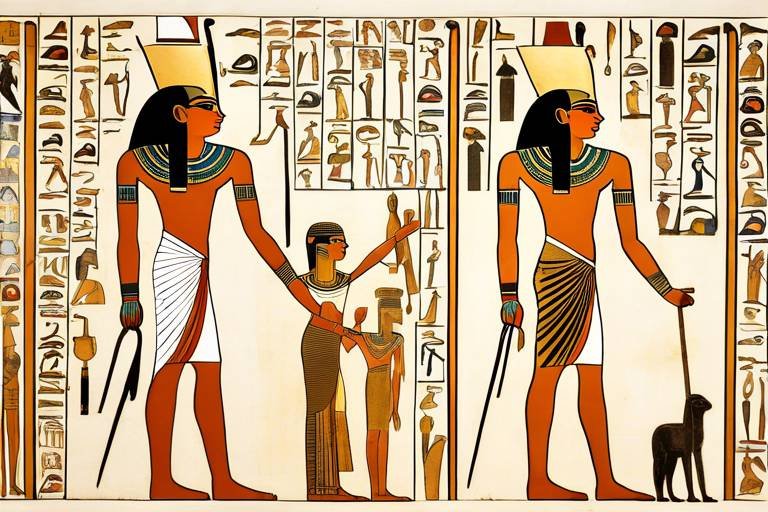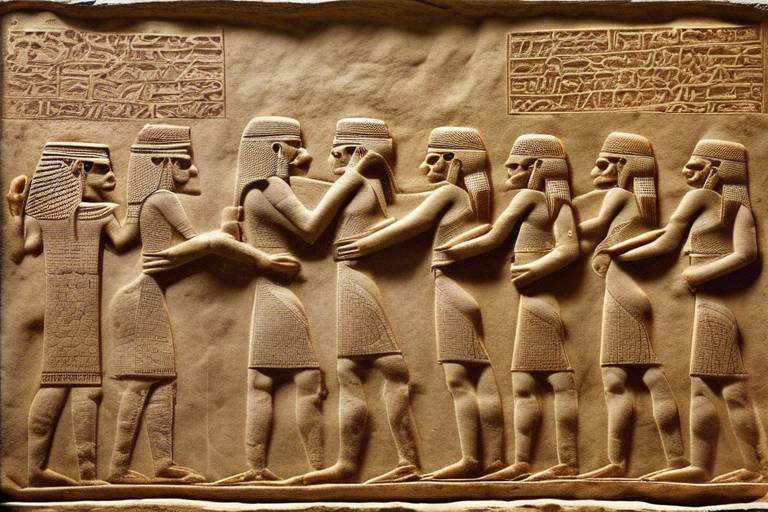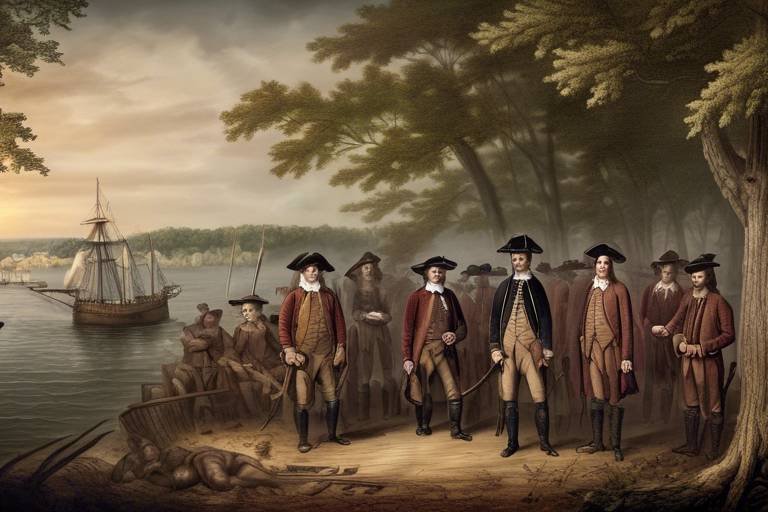The Secrets of Ancient Egyptian Symbolism in Art
Exploring the profound meanings and hidden messages behind the symbols used in ancient Egyptian art, shedding light on the cultural, religious, and historical significance of these artistic expressions.
Ancient Egyptian art is a treasure trove of symbolism, where every stroke and shape holds a deeper meaning waiting to be deciphered. The intricate symbols woven into their art pieces serve as windows into a world where the spiritual, the earthly, and the divine converge in mesmerizing harmony.
Imagine standing before a grand mural adorned with hieroglyphs, each symbol whispering tales of gods, pharaohs, and the afterlife. These ancient artists were not merely decorators but storytellers, using symbols as their language to convey truths that transcended time and space.
Just as an architect carefully selects each brick to build a sturdy structure, the Egyptian artists meticulously chose each symbol to construct a narrative that resonated with the soul. Every color, every animal, every deity depicted was a piece of a cosmic puzzle, inviting the viewer to unlock the mysteries of existence.
From the majestic pyramids to the intricate tombs, Egyptian art is a tapestry woven with symbols that speak of life, death, rebirth, and the eternal dance of the universe. The symbols were not mere decorations but gateways to a realm where the mundane met the divine, where the seen merged with the unseen.
As we delve into the secrets of ancient Egyptian symbolism in art, we embark on a journey of discovery, where each symbol is a key that unlocks a new chamber of knowledge and wonder. Let us unravel the enigmatic language of the ancients and marvel at the profound wisdom encoded in their art.
- What role did symbols play in ancient Egyptian society?
- How did animals symbolize different concepts in Egyptian art?
- What were the symbolic meanings of colors in ancient Egyptian art?
- Why were hieroglyphs important in Egyptian artistic expressions?
- How did Egyptian gods and goddesses symbolize aspects of nature and human life?
- What significance did numbers hold in Egyptian art?
- How has Egyptian symbolism influenced modern art?
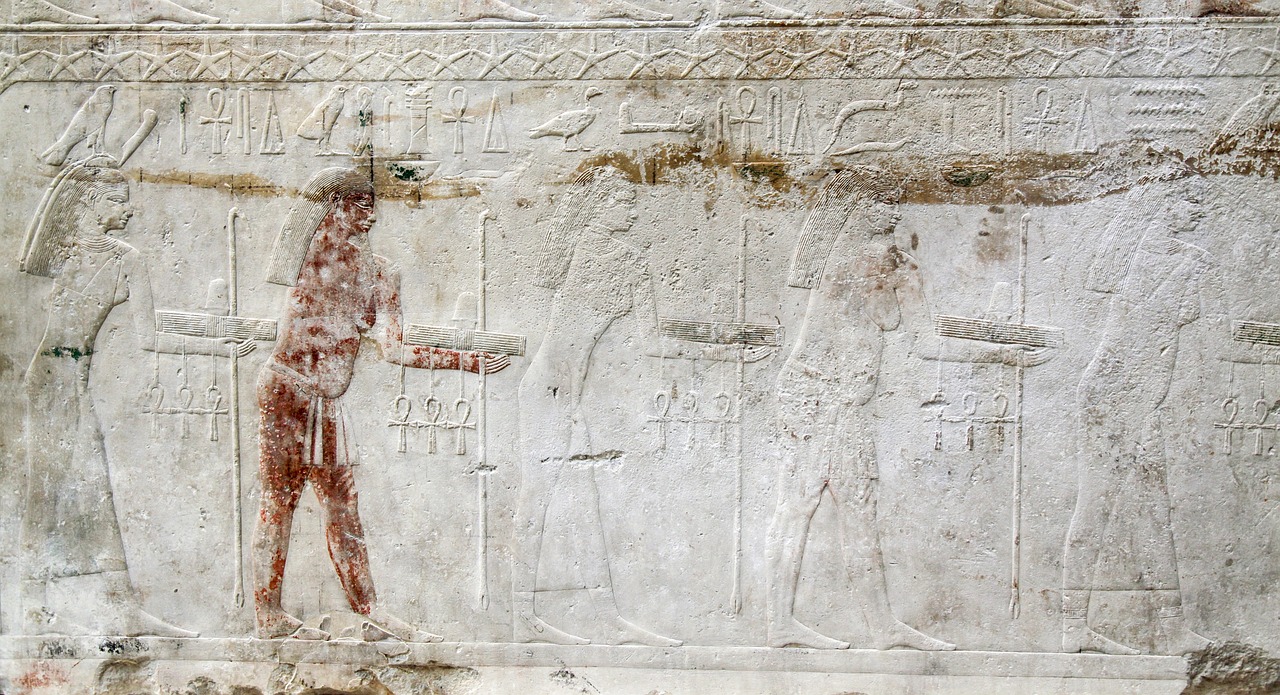
The Importance of Symbols in Ancient Egyptian Art
Exploring the profound meanings and hidden messages behind the symbols used in ancient Egyptian art, shedding light on the cultural, religious, and historical significance of these artistic expressions.
Symbols played a crucial role in conveying complex ideas and beliefs in ancient Egyptian society, influencing various aspects of their art forms and cultural practices. These symbols were not merely decorative elements but served as a language of their own, communicating deep-rooted concepts and philosophies.
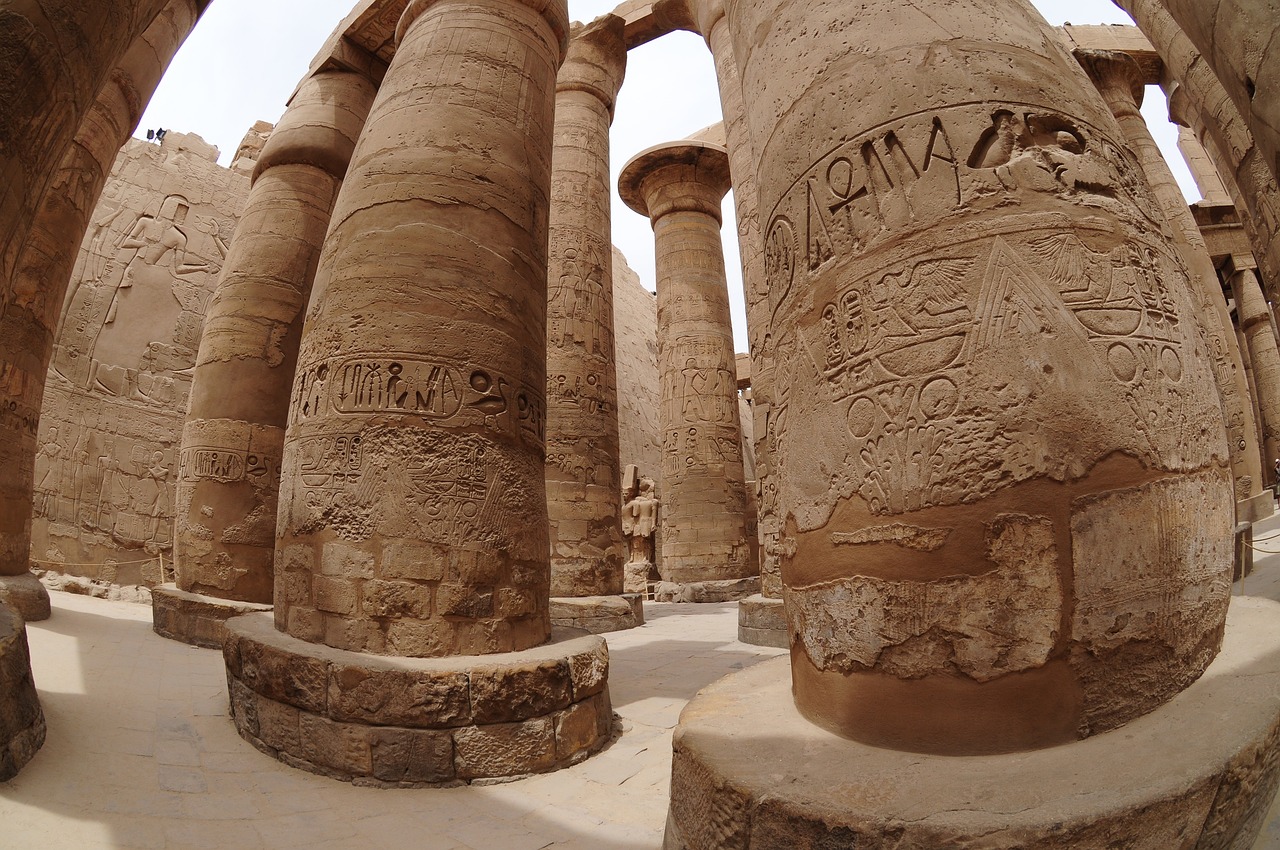
The Role of Animals in Egyptian Symbolism
Exploring the profound meanings and hidden messages behind the symbols used in ancient Egyptian art, shedding light on the cultural, religious, and historical significance of these artistic expressions.
In ancient Egyptian art, animals played a crucial role in symbolizing various deities, qualities, and concepts that were deeply rooted in their religious and cultural beliefs. Each animal held a specific meaning and represented different aspects of the divine and natural world.
For example, the revered scarab beetle symbolized the cycle of life, death, and rebirth, while the powerful lion represented strength and protection. The graceful cat was associated with femininity and fertility, and the ibis bird symbolized wisdom and knowledge.
Animals were not merely decorative elements in Egyptian art but were revered for their symbolic significance, serving as a bridge between the earthly realm and the divine. They were believed to embody the essence of various gods and goddesses, acting as intermediaries between humans and the spiritual realm.
Through intricate depictions and artistic representations, ancient Egyptian artists imbued animals with sacred meanings, creating a rich tapestry of symbolism that reflected their deep spiritual beliefs and cultural values.
- What is the significance of animal symbolism in ancient Egyptian art?
- How did animals influence Egyptian religious beliefs?
- Why were certain animals chosen as symbols in Egyptian art?
Animals in ancient Egyptian art symbolized various deities, qualities, and concepts, serving as powerful symbols that conveyed complex ideas and beliefs.
Animals were integral to Egyptian religious beliefs, representing different aspects of the divine and playing a crucial role in religious rituals and practices.
Ancient Egyptians selected animals as symbols based on their unique characteristics and qualities, attributing specific meanings to each creature based on their cultural significance and religious beliefs.

The Symbolism of Colors in Egyptian Art
Exploring the profound meanings and hidden messages behind the symbols used in ancient Egyptian art, shedding light on the cultural, religious, and historical significance of these artistic expressions.
Symbols played a crucial role in conveying complex ideas and beliefs in ancient Egyptian society, influencing various aspects of their art forms and cultural practices.
Animals held symbolic significance in ancient Egyptian art, representing various deities, qualities, and concepts that were integral to their religious and cultural beliefs.
Colors were not merely decorative elements in ancient Egyptian art but held symbolic meanings related to life, death, rebirth, and the natural world, enriching the visual narratives of their artworks.
The vibrant colors used in ancient Egyptian art were not just visually striking but also carried deep symbolic significance. Each color had a specific meaning and was carefully chosen to convey powerful messages to the viewers. For example:
| Color | Meaning |
|---|---|
| Gold | Associated with the sun god Ra, symbolizing divinity and eternal life. |
| Blue | Represented the sky and the Nile, symbolizing fertility and rebirth. |
| Red | Linked to the god of chaos, symbolizing vitality, energy, and power. |
| Green | Associated with vegetation, growth, and rejuvenation, symbolizing renewal and rebirth. |
The careful selection and use of colors in Egyptian art not only added aesthetic value but also infused deeper layers of meaning, connecting the artworks to the spiritual and symbolic world of ancient Egypt.
Hieroglyphs were more than just a form of writing in ancient Egypt; they were also powerful symbols that conveyed both literal and symbolic meanings in art, offering insights into their language and culture.
The diverse pantheon of Egyptian deities represented in art symbolized various aspects of nature, human life, and the cosmos, reflecting the complex religious beliefs and practices of ancient Egyptians.
Numbers held symbolic significance in ancient Egyptian art, representing cosmic principles, divine order, and mystical concepts that were intricately woven into the artistic expressions of the time.
Symbolism played a significant role in shaping the architectural designs of ancient Egyptian structures, reflecting religious beliefs, social hierarchy, and cultural values through monumental forms and decorative motifs.
The rich symbolism of ancient Egyptian art continues to inspire and influence modern artists, who draw upon its mystical, cultural, and aesthetic elements to create contemporary artworks that resonate with timeless themes.

The Significance of Hieroglyphs in Egyptian Art
Hieroglyphs, the intricate system of writing in ancient Egypt, were not merely a means of communication but also held profound symbolic significance in Egyptian art. These pictorial symbols were used to convey both literal messages and deeper meanings, enriching the visual storytelling of ancient Egyptian artworks. Each hieroglyph represented a concept, an object, or a sound, allowing artists to infuse their creations with layers of symbolism and complexity. The intricate nature of hieroglyphs added a mysterious and mystical aura to Egyptian art, inviting viewers to decipher the hidden messages and unravel the secrets of the past.

The Symbolism of Gods and Goddesses in Egyptian Art
When delving into the world of ancient Egyptian art, one cannot ignore the profound symbolism attached to the gods and goddesses depicted in their artworks. These divine figures were not merely representations of deities but embodied complex layers of meaning that reflected the interconnectedness of nature, humanity, and the cosmos.
Each god and goddess in Egyptian art symbolized specific aspects of life, such as fertility, protection, wisdom, and power. For example, the goddess Isis, often depicted with outstretched wings, symbolized motherhood, magic, and healing. In contrast, the god Anubis, with the head of a jackal, represented death, embalming, and the afterlife.
Moreover, the depictions of gods and goddesses in Egyptian art were not just artistic renderings but served a spiritual purpose as well. The intricate symbols and attributes associated with each deity conveyed their roles in the divine hierarchy and their influence on human affairs.
For instance, the falcon-headed god Horus symbolized kingship, protection, and the sky, while the lioness goddess Sekhmet embodied war, healing, and justice. These symbolic representations were not only visually striking but also held deep religious significance for the ancient Egyptians, shaping their beliefs, rituals, and worldview.
Furthermore, the interactions between different gods and goddesses in Egyptian art revealed intricate mythological narratives and cosmic struggles that mirrored the eternal cycles of creation, destruction, and rebirth. The symbolism embedded in these divine relationships provided insights into the complex interplay of forces that governed the universe according to Egyptian cosmology.
In essence, the gods and goddesses depicted in Egyptian art were not mere figures of worship but embodied archetypal symbols that represented the fundamental forces of nature and the metaphysical principles that governed the world. Their symbolism transcended mere artistic representation, offering a glimpse into the profound spiritual beliefs and philosophical insights of ancient Egyptian civilization.
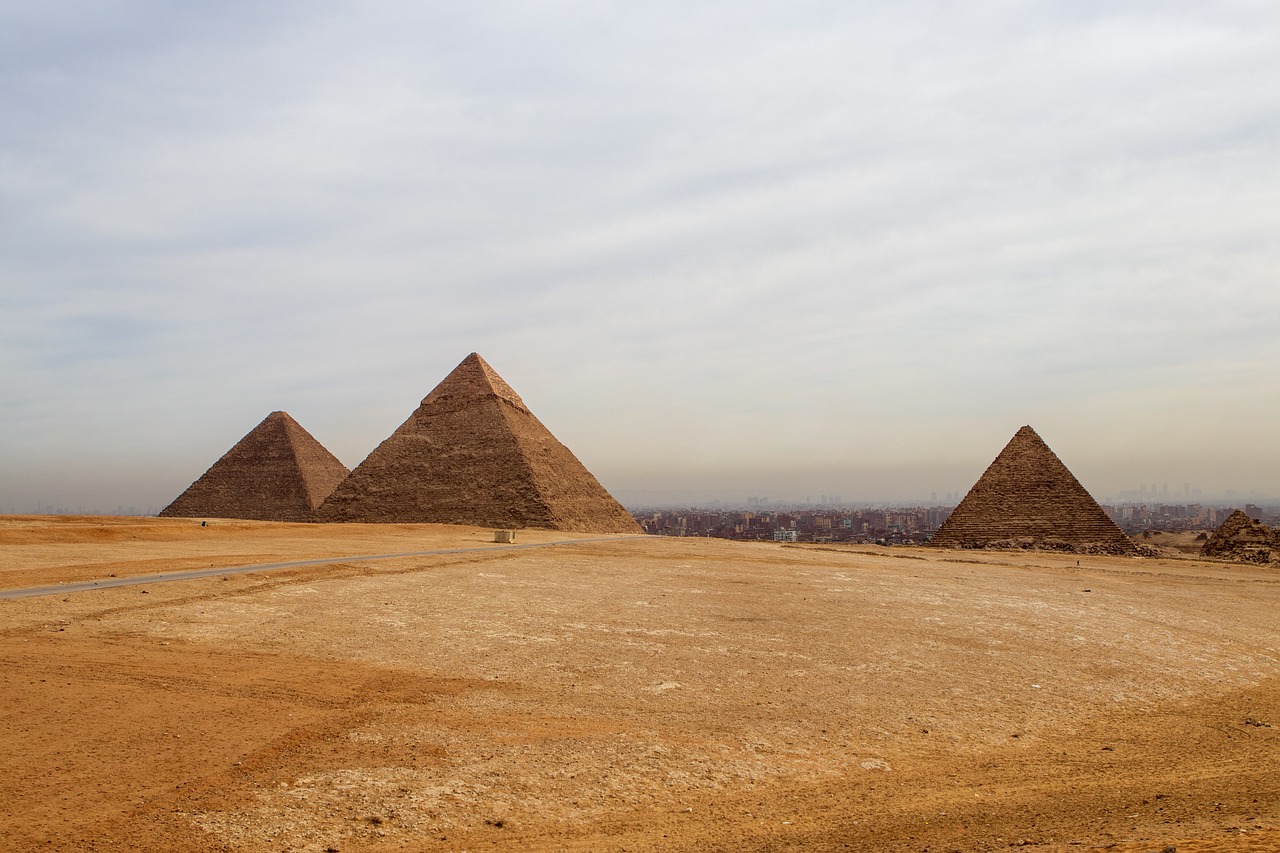
The Symbolism of Numbers in Egyptian Art
Exploring the profound meanings and hidden messages behind the symbols used in ancient Egyptian art, shedding light on the cultural, religious, and historical significance of these artistic expressions.
In ancient Egyptian art, numbers held a deep symbolic significance, going beyond mere numerical value to represent cosmic principles, divine order, and mystical concepts that were intricately woven into the artistic expressions of the time. Each number carried a unique meaning and was often associated with specific deities, rituals, or aspects of the natural world.
For example, the number three symbolized completeness and balance, reflecting the triad of major Egyptian deities such as Osiris, Isis, and Horus. It also represented the cycle of birth, life, and death, emphasizing the eternal nature of existence in Egyptian belief systems.
The number seven was another significant symbol in Egyptian art, symbolizing perfection, creation, and the seven sacred principles of the universe. It was often linked to the seven heavenly bodies known to ancient Egyptians, including the sun, moon, and five visible planets, each associated with a specific deity and cosmic force.
Furthermore, the number twelve held special importance in Egyptian symbolism, representing cosmic order and the twelve divisions of the sky as observed by ancient astronomers. It was linked to the zodiac signs and the annual cycle of the sun, embodying the concept of time, cycles, and renewal in Egyptian art and religious practices.
Through the intricate use of numbers in their art, ancient Egyptians conveyed complex philosophical ideas, spiritual beliefs, and cosmological concepts, creating a rich tapestry of symbolic meanings that continue to fascinate and inspire scholars and artists to this day.
- Q: What role did animals play in Egyptian symbolism?
- A: Animals held symbolic significance in Egyptian art, representing various deities, qualities, and concepts integral to their religious beliefs.
- Q: How did colors contribute to the symbolism in Egyptian art?
- A: Colors in Egyptian art held symbolic meanings related to life, death, rebirth, and the natural world, enriching the visual narratives of their artworks.
- Q: What is the significance of hieroglyphs in Egyptian art?
- A: Hieroglyphs were powerful symbols that conveyed literal and symbolic meanings in art, offering insights into Egyptian language and culture.
- Q: How did symbolism influence Egyptian architecture?
- A: Symbolism played a significant role in shaping the architectural designs of ancient Egyptian structures, reflecting religious beliefs and cultural values.
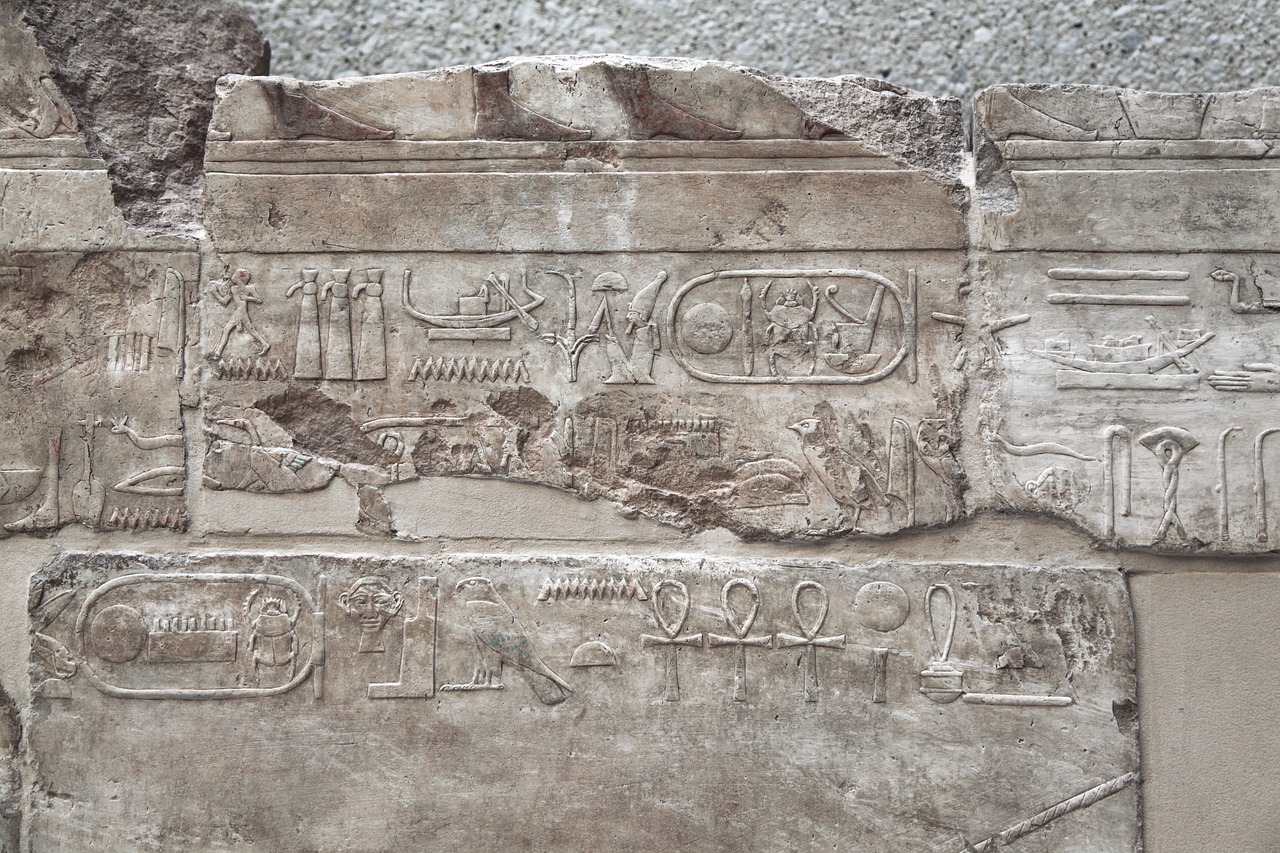
The Influence of Symbolism on Egyptian Architecture
The architectural designs of ancient Egypt were deeply influenced by symbolism, reflecting the intricate beliefs and values of the society. The monumental structures such as the pyramids, temples, and tombs were not merely functional buildings but were laden with symbolic meanings that communicated spiritual, religious, and cultural ideologies.
One of the key aspects of Egyptian architecture was the use of hieroglyphs and intricate carvings on the walls of temples and tombs. These symbols were not just decorative elements but served as a form of communication with the gods and the afterlife. The intricate reliefs and paintings depicted scenes from mythology, rituals, and daily life, imbuing the architecture with layers of symbolic significance.
The layout and orientation of Egyptian temples were also symbolic, aligning with celestial bodies and natural elements. The axis of the temples often faced east towards the rising sun, symbolizing rebirth and regeneration. The intricate architectural details such as columns, pylons, and obelisks were not just structural components but represented cosmic forces and deities, creating a sacred space that bridged the earthly and divine realms.
The use of sacred geometry and proportions in Egyptian architecture also held symbolic meaning. The precise measurements and alignment of structures were believed to reflect divine order and harmony in the universe. The symmetry and balance in the design of temples and tombs were thought to channel cosmic energies and connect the physical world with the spiritual realm.
Furthermore, the materials used in Egyptian architecture, such as limestone, granite, and sandstone, were chosen for their symbolic connotations. Each type of stone carried its own significance, representing durability, strength, and eternal life. The intricate carvings and paintings on the walls were often colored with symbolic hues, such as blue for the sky and water, and gold for the sun and divinity.
In conclusion, the influence of symbolism on Egyptian architecture was profound and multifaceted, shaping not only the physical structures but also the spiritual and cultural landscapes of ancient Egypt. The architectural legacy of the Egyptians continues to fascinate and inspire architects and scholars alike, offering a glimpse into a civilization where art, religion, and symbolism were intricately intertwined.

The Legacy of Egyptian Symbolism in Modern Art
The influence of ancient Egyptian symbolism on modern art is undeniable, as artists continue to draw inspiration from the rich and mystical elements of Egyptian culture. From the intricate hieroglyphs to the symbolic representations of gods and goddesses, the legacy of Egyptian art lives on in contemporary artworks around the world. Modern artists often incorporate Egyptian symbols and themes into their creations, infusing their work with a sense of mystery and timelessness.
One prominent example of the legacy of Egyptian symbolism in modern art is the use of geometric shapes and patterns reminiscent of ancient Egyptian architecture and design. Artists explore the spiritual and symbolic meanings behind these shapes, incorporating them into their artwork to evoke a sense of ancient wisdom and mysticism. The use of vibrant colors and intricate details inspired by Egyptian art further enhances the connection between the past and the present, creating a visual language that transcends time.
Moreover, the themes of life, death, rebirth, and the natural world, which were central to ancient Egyptian symbolism, continue to resonate with modern artists seeking to explore universal truths and existential questions through their art. By tapping into the symbolic language of ancient Egypt, contemporary artists are able to infuse their work with deeper meanings and connections to the human experience, creating artworks that speak to the soul and spark contemplation.
In conclusion, the legacy of Egyptian symbolism in modern art serves as a bridge between the ancient past and the present, allowing artists to delve into the mysteries of the past while creating new and innovative expressions that reflect the enduring relevance of Egyptian art in today's world.
Frequently Asked Questions
- What is the significance of symbols in ancient Egyptian art?
Symbols in ancient Egyptian art held deep cultural, religious, and historical meanings. They were used to convey complex ideas and beliefs, enriching the visual narratives of artworks and influencing various aspects of Egyptian society.
- How did animals play a role in Egyptian symbolism?
Animals in ancient Egyptian art represented deities, qualities, and concepts essential to their religious and cultural beliefs. They served as symbolic elements that conveyed deeper meanings and connections to the natural world.
- What do colors symbolize in Egyptian art?
Colors in Egyptian art were not just decorative but held symbolic meanings related to life, death, rebirth, and the cosmos. They added layers of significance to artistic expressions, reflecting the profound beliefs of the ancient Egyptians.
- Why were hieroglyphs important in Egyptian art?
Hieroglyphs were powerful symbols in ancient Egypt, serving as both a form of writing and conveying symbolic meanings in art. They provided insights into the language, culture, and religious practices of the Egyptians.
- How did symbolism influence Egyptian architecture?
Symbolism played a crucial role in shaping the architectural designs of ancient Egyptian structures. It reflected religious beliefs, social hierarchy, and cultural values through monumental forms and decorative motifs, showcasing the depth of Egyptian symbolism.

